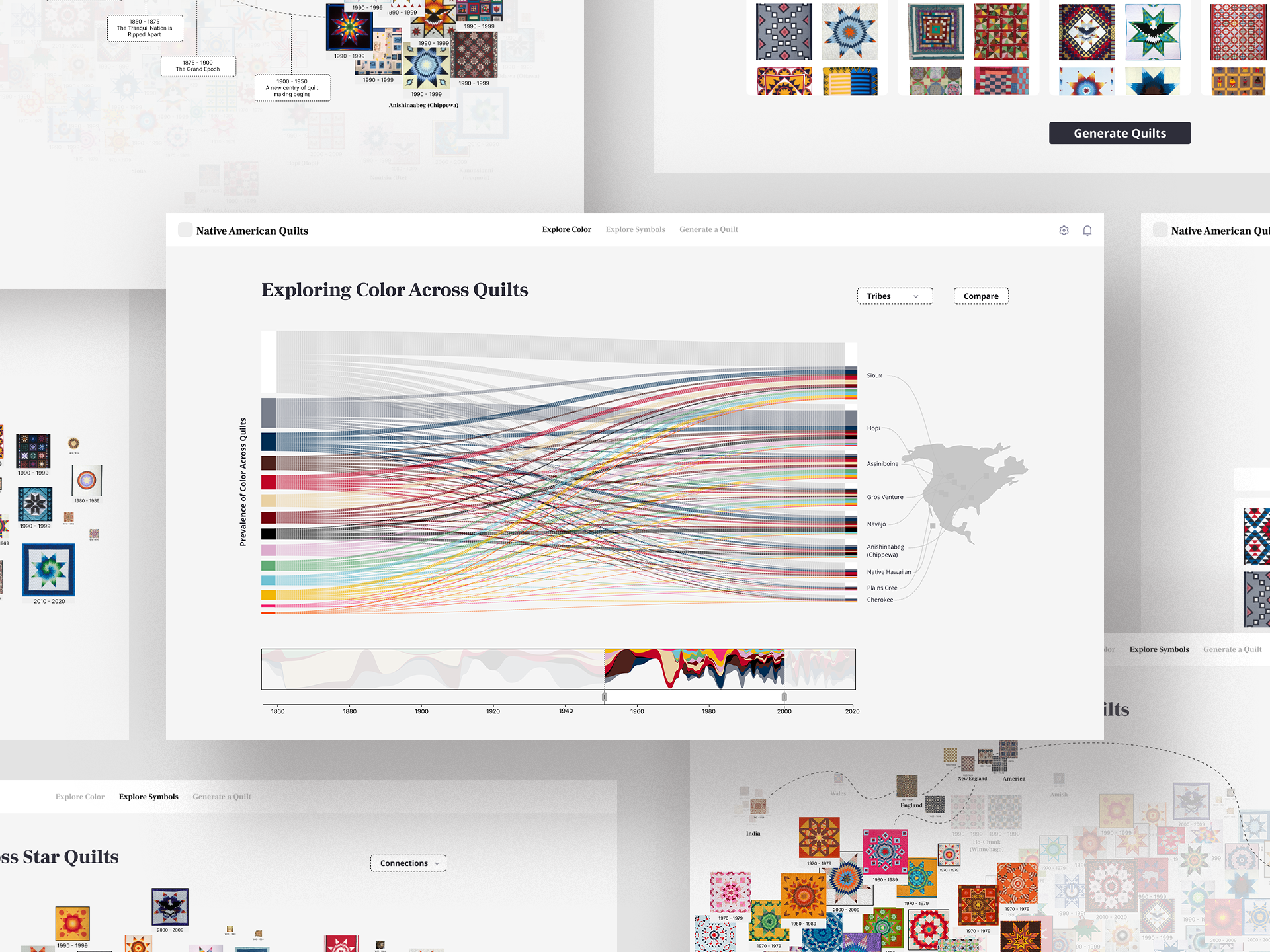
Exploring Native American Quilting Aesthetics
Data Visualization + Cultural Analysis + Interaction Design
Overview
Brief
Exploring Native American Quilting Aesthetics is a project aimed at uncovering and visualizing the rich art form of Native American quilting. By examining historical and cultural influences, the project celebrates intricate beauty and symbolism in these quilts. Using data analysis and visualization, an interactive tool allows users to explore quilting aesthetics, fostering appreciation and understanding. Emphasizing cultural sensitivity and accuracy, the project provides an educational experience for enthusiasts, educators, and Native American community members.
Duration
Sept - Oct 2022
Role
Data Analyst, Developer
Skills
- Background Research
- Book Research
- Interviews
- Web Scraping
Tools
- Python
- RunwayML
- RawGraphs
- Figma
Problem
Limited awareness and documentation of Native American quilting culture
Quilts, introduced by European settlers, have been integrated into Native American traditions, yet the art form remains largely unrecognized beyond these communities. Misrepresentation and lack of comprehensive documentation have further obscured its evolution and significance.
Research Question
How might we explore and visualize the evolution and interconnectedness of Native American quilting aesthetics?
This question investigates the evolution of quilting aesthetics across Native American tribes and explores new forms of connection using generative technology.
Value System
Our process and outcome were guided by a set of values that served as a moral compass for the project
Process Value System
Participatory
Collaborating with experts in the field to guide the project focus and research questions.
Accuracy
Fact-checking research with experts and designing ways to navigate data inconsistencies.
Project Value System
Self-initiated Learning
Promoting discovery-led and exploratory learning.
Sensitive
Ensuring that the final product is respectful of Native American history, culture, and tradition.
Transparent
Making data sources and processes openly available to enable others to build on our work.
Research
Deep dive into the history and evolution of Native American quilting
Background Research
Understanding historical context and influences.
Book Research
Utilizing resources from Harvard libraries.
Interviews
Consulting with experts in Native American quilting.
Web Scraping
Collecting data from online resources and databases.
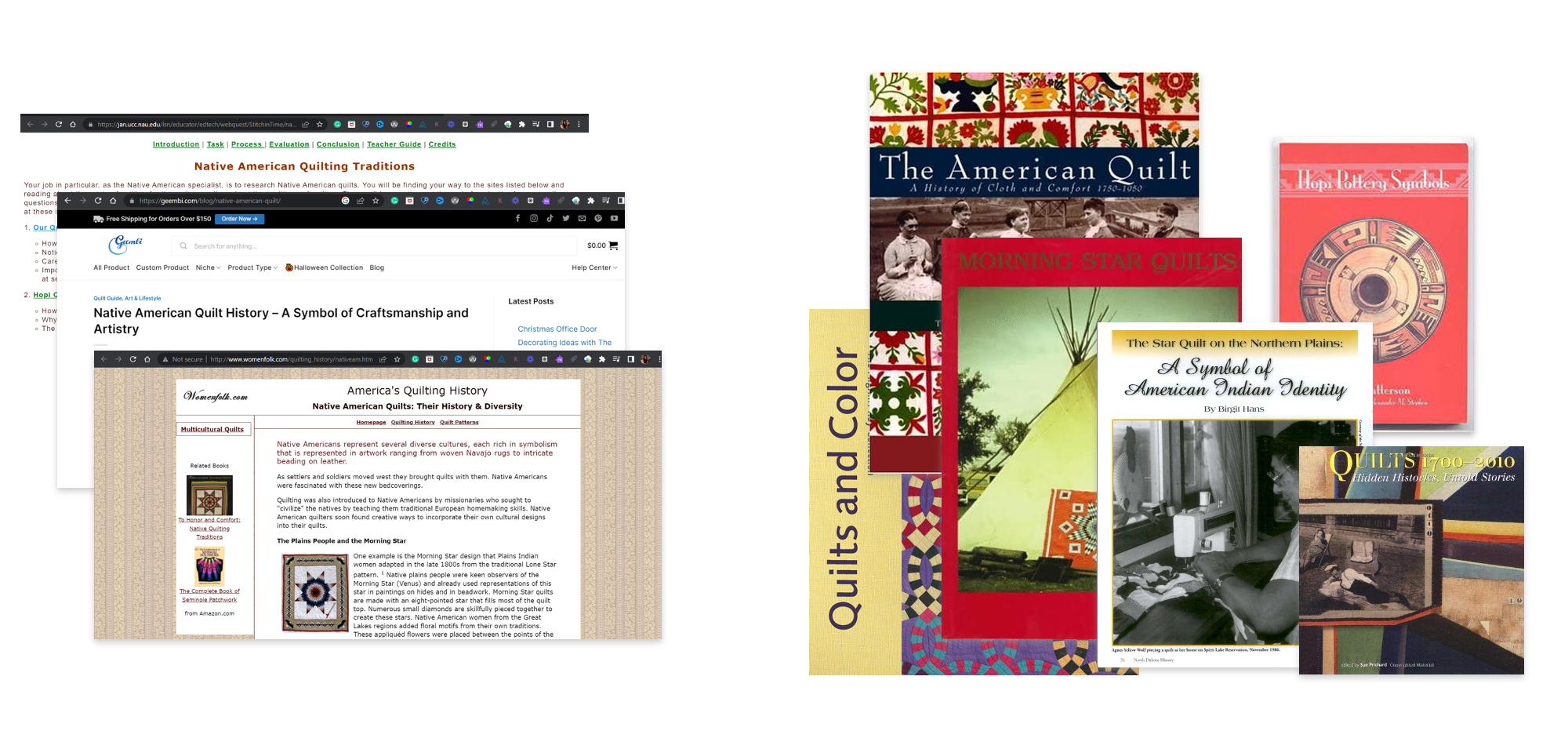
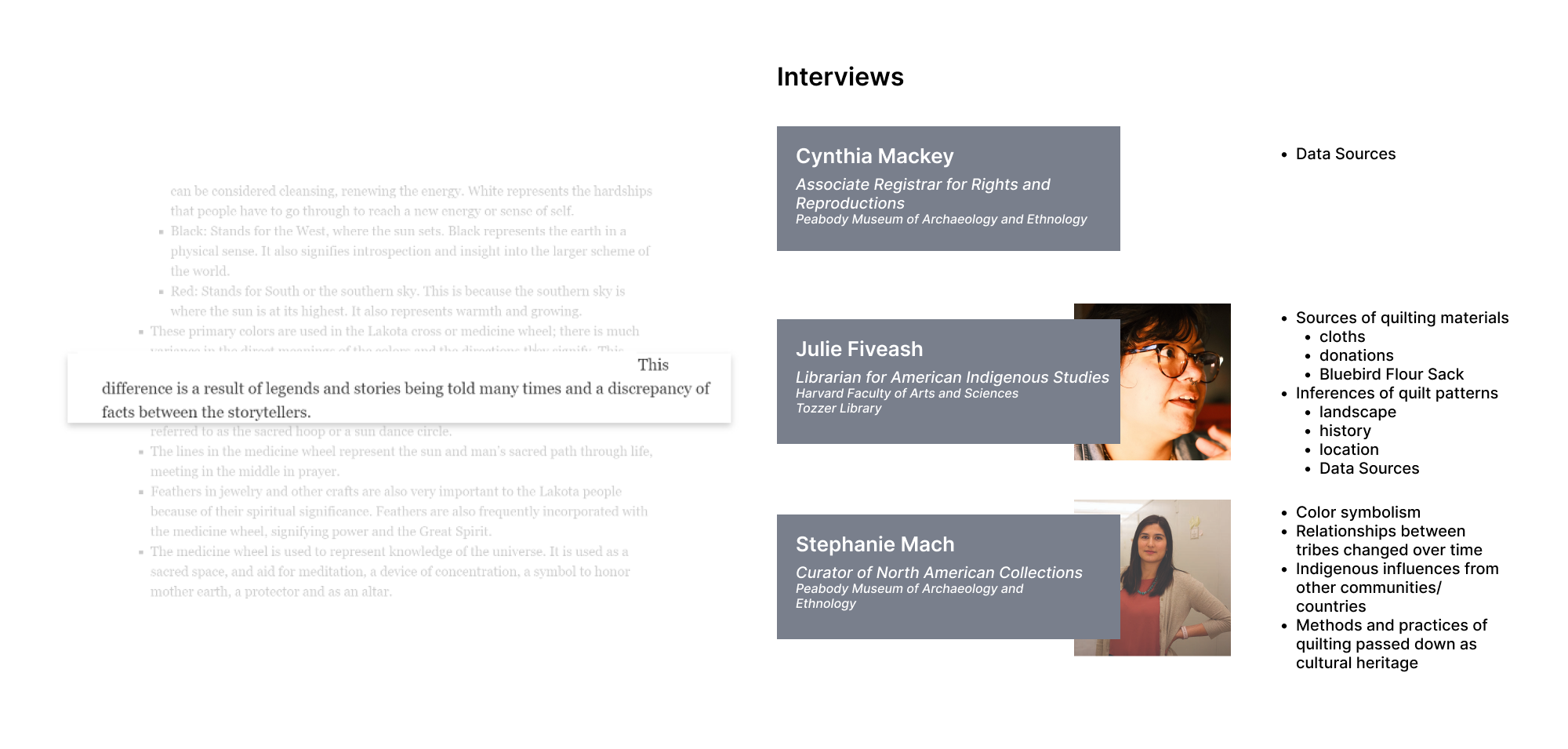
Insight 1
Quilting culture is dynamic and evolving
Native American quilting incorporates cultural symbolism and storytelling, evolving through influences from non-native communities and boarding schools.
Insight 2
Visual relationships reflect cultural connections
Quilting aesthetics, including color and motifs, reveal a blend of influences from various Native American tribes and beyond.
Insight 3
Generative technology offers new perspectives
Using tools like StyleGAN and RunwayML, we can explore alternate quilting aesthetics and hypothetical connections between tribes, revealing new insights into cultural exchange.
Stakeholders
Identifying and addressing the needs of diverse stakeholders
General Audience
Learn about Native American quilting culture.
Educators/Curators
Need accurate, sensitive representation of data.
Native Americans
Honest and accurate inferences.
Data Preparation
Preparing and cleaning data for analysis
Data acquisition faced several challenges. Sources included university departments, heritage centers, missionary boarding schools, and museums. Challenges included the lack of well-documented images of quilts and inconsistent attributes.
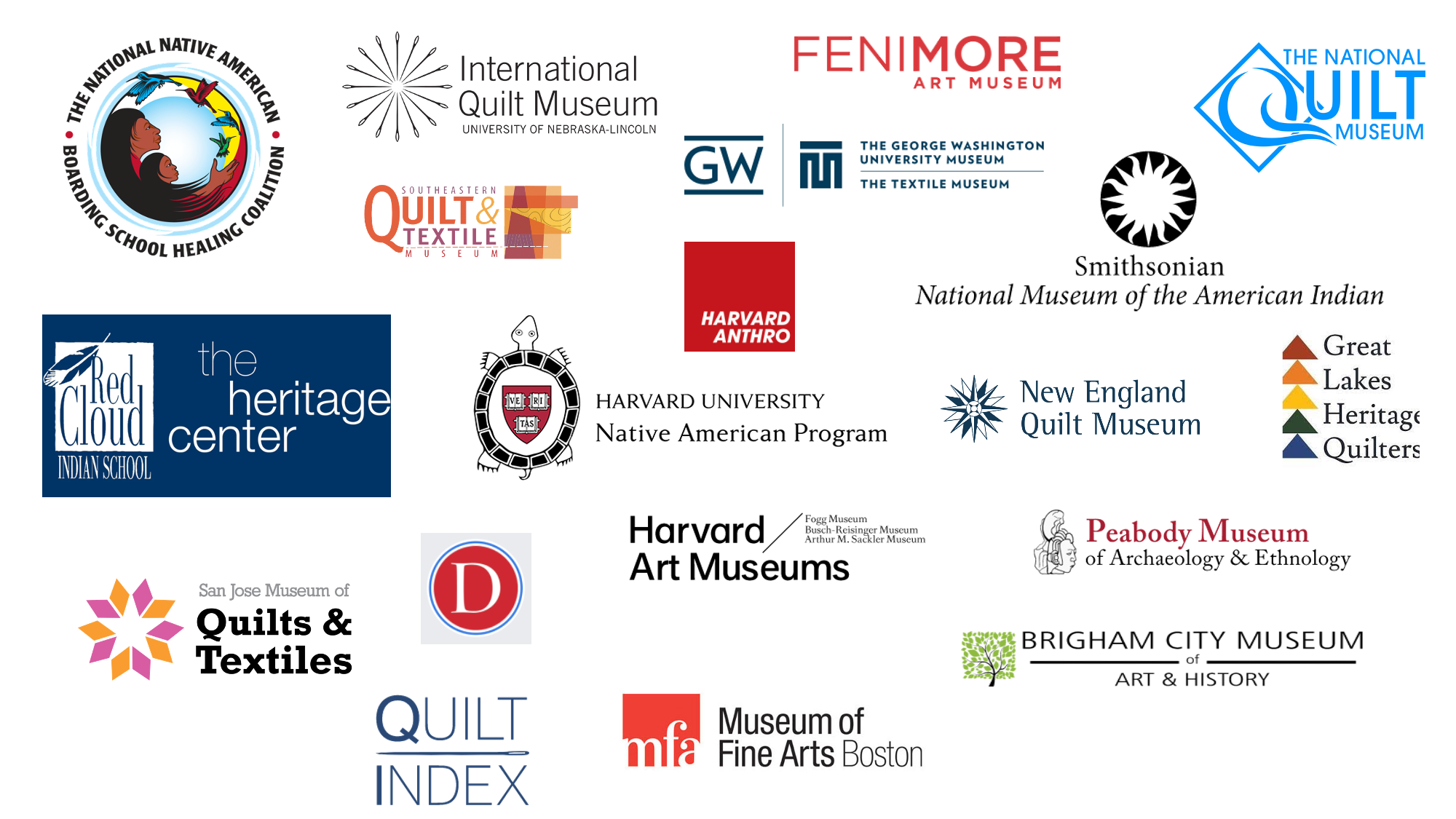
Standardizing data for accurate analysis
Attributes such as date, location, period, dimensions, technique, primary fabric, and fiber were consistent. Tribe information was mostly consistent, while the quilt maker's name and history were inconsistent. We created 14 color buckets and used edge detection and clustering techniques to standardize the data.

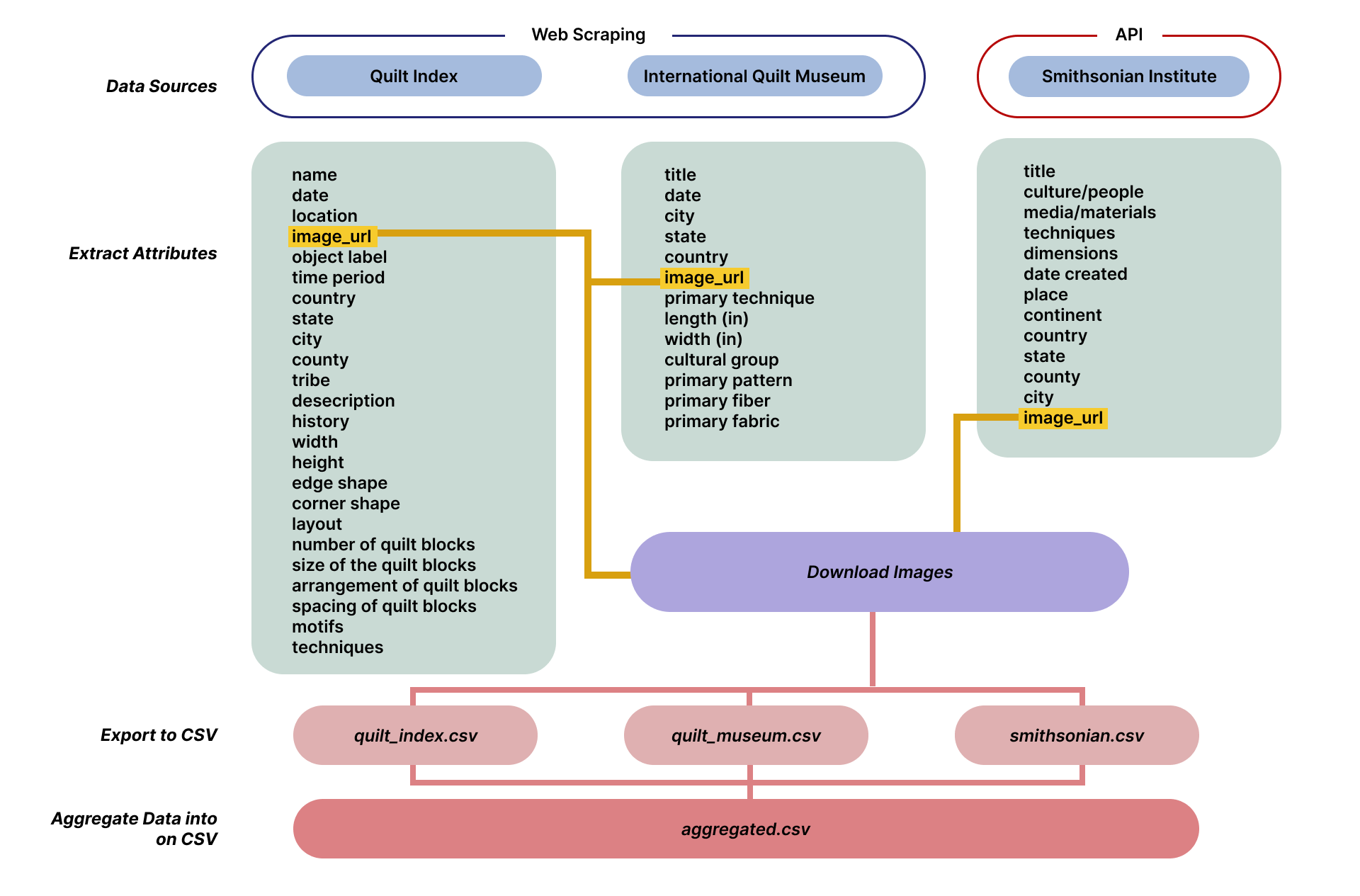
Data Acquisition Process Part 1
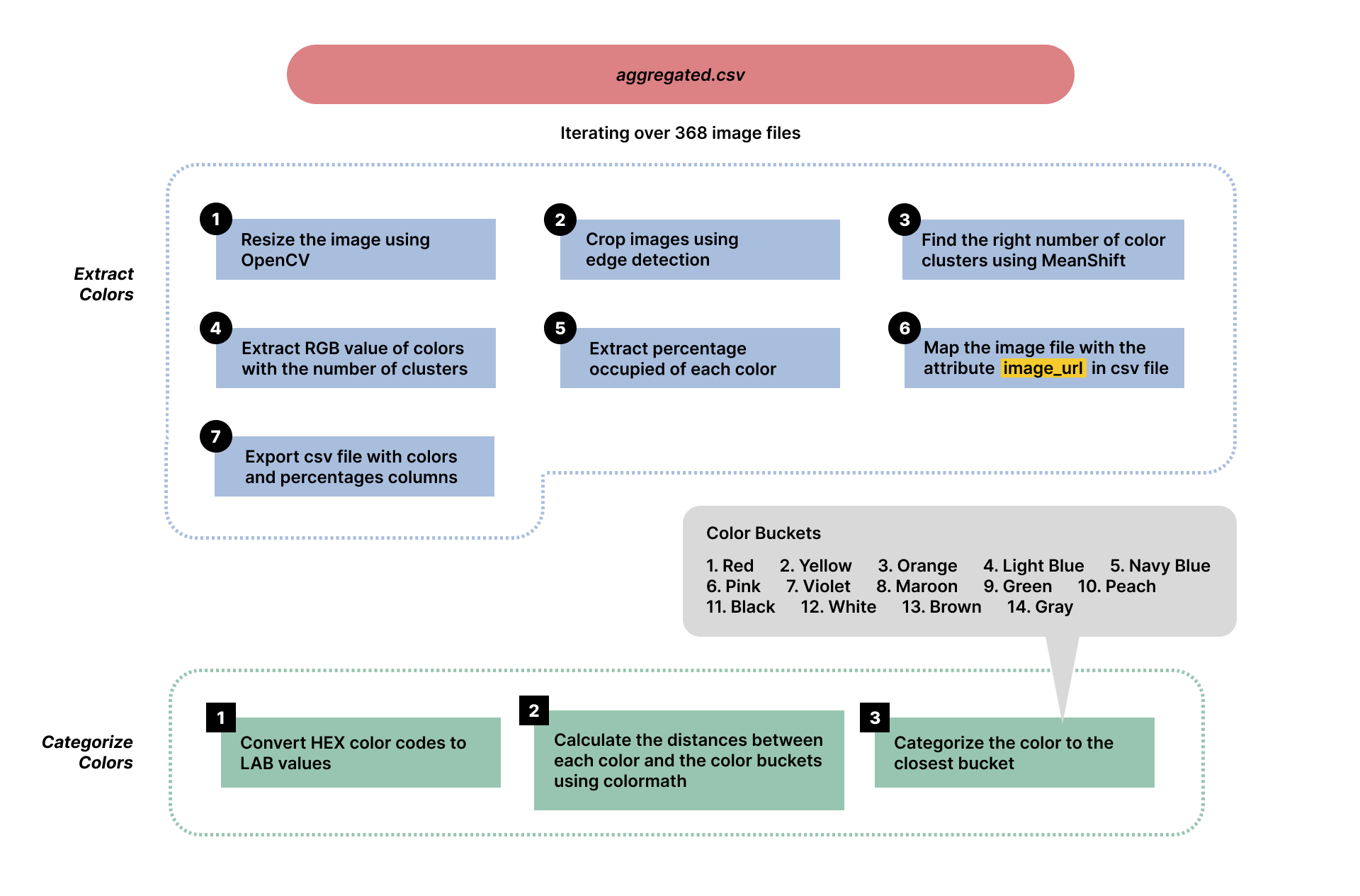
Data Acquisition Process Part 2
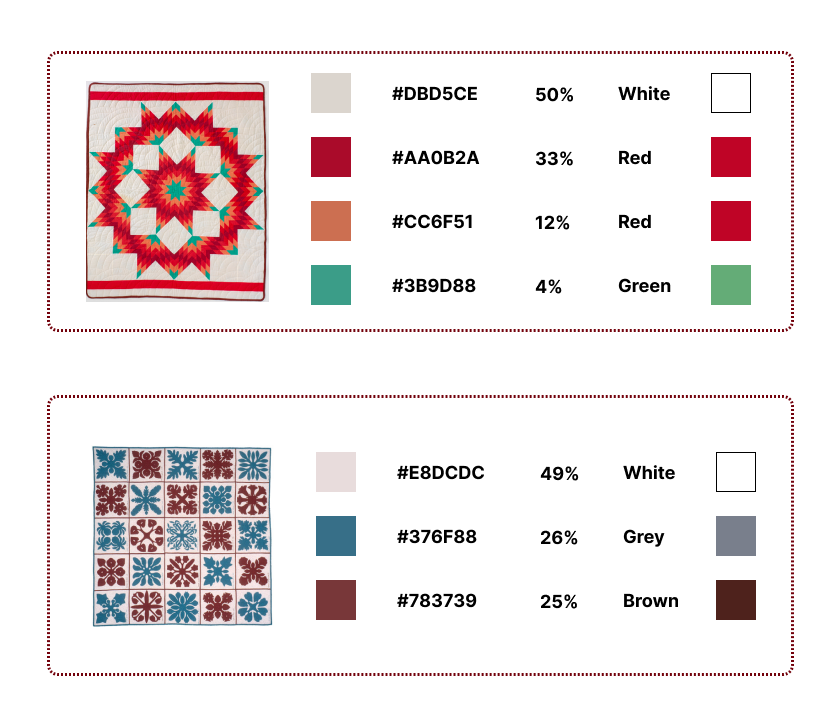
Examples of Color Extractions
Solution
Developing an interactive tool to visualize quilting aesthetics
The solution involved creating a comprehensive digital platform where users can interact with visual data representing Native American quilts. By leveraging advanced data visualization techniques, the tool allows users to explore the evolution of quilting aesthetics across different tribes, understand cultural connections, and appreciate the intricate designs and symbolism. This interactive tool includes features like:
Color and Motif Analysis
Visual representations of color usage and motifs across different tribes and time periods.
Generative Models
Explorations of hypothetical quilting aesthetics using AI to simulate potential future designs.
Detailed Quilt Information
Access to detailed historical and cultural contexts for each quilt, enhancing user understanding and appreciation.
General Model Implementation
Using generative models to explore interconnectedness
Generative models offer new insights. We used StyleGAN and RunwayML to explore potential future designs and cultural exchange between tribes, providing a deeper understanding of their interconnectedness.
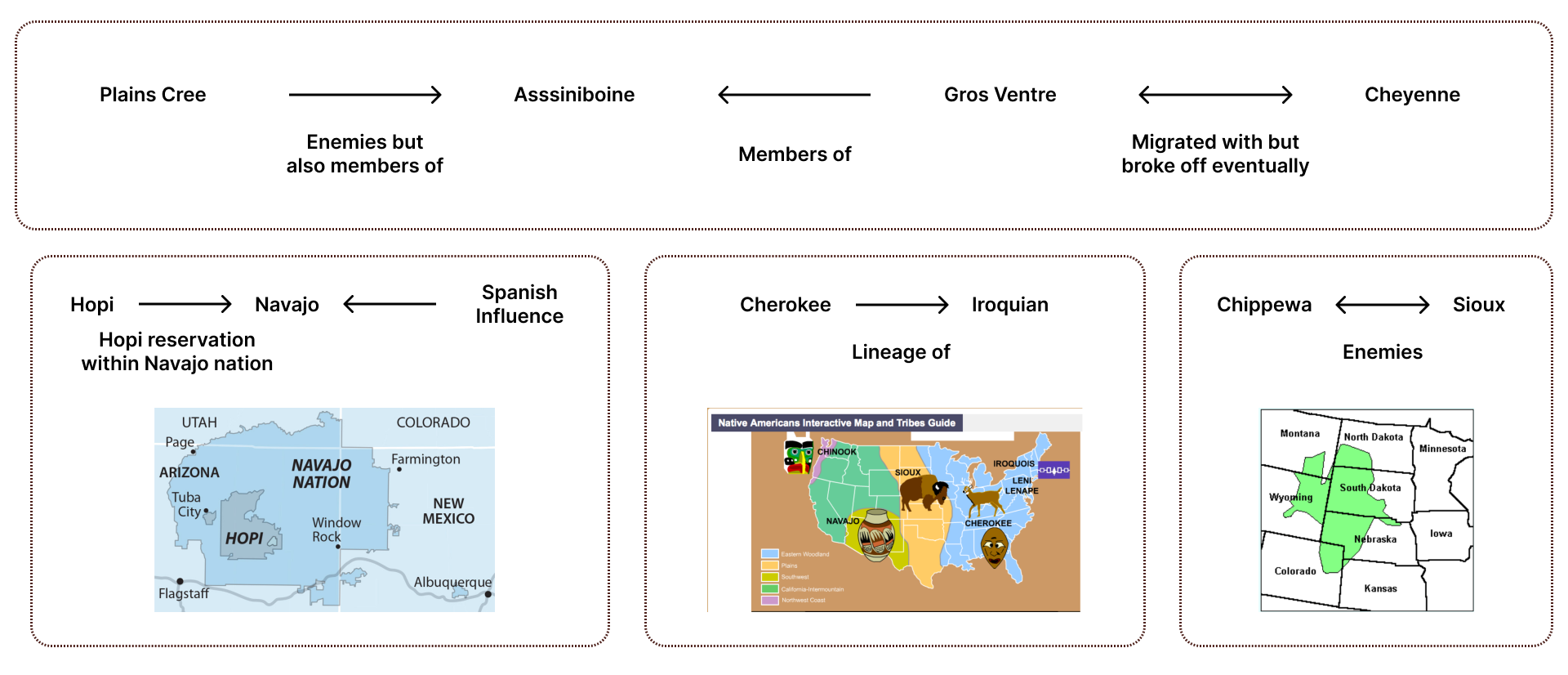
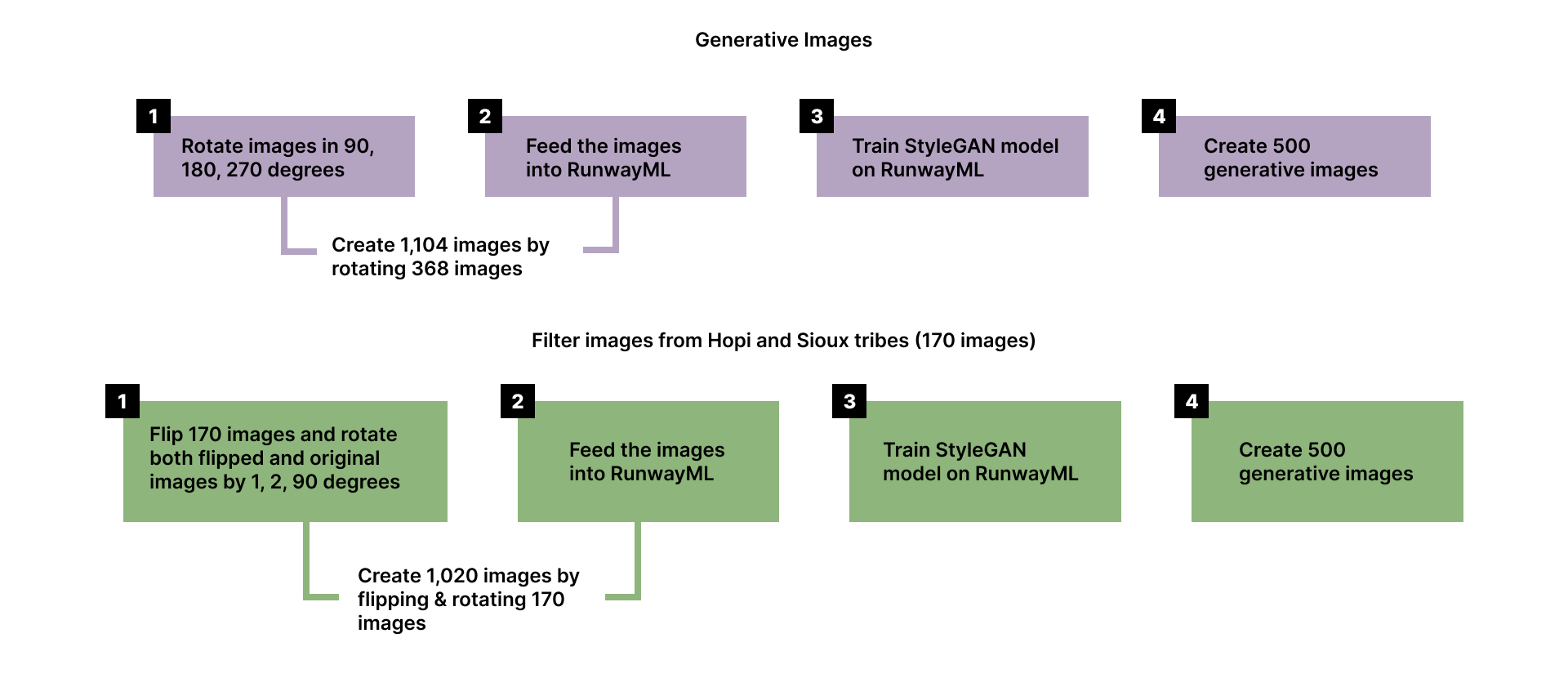
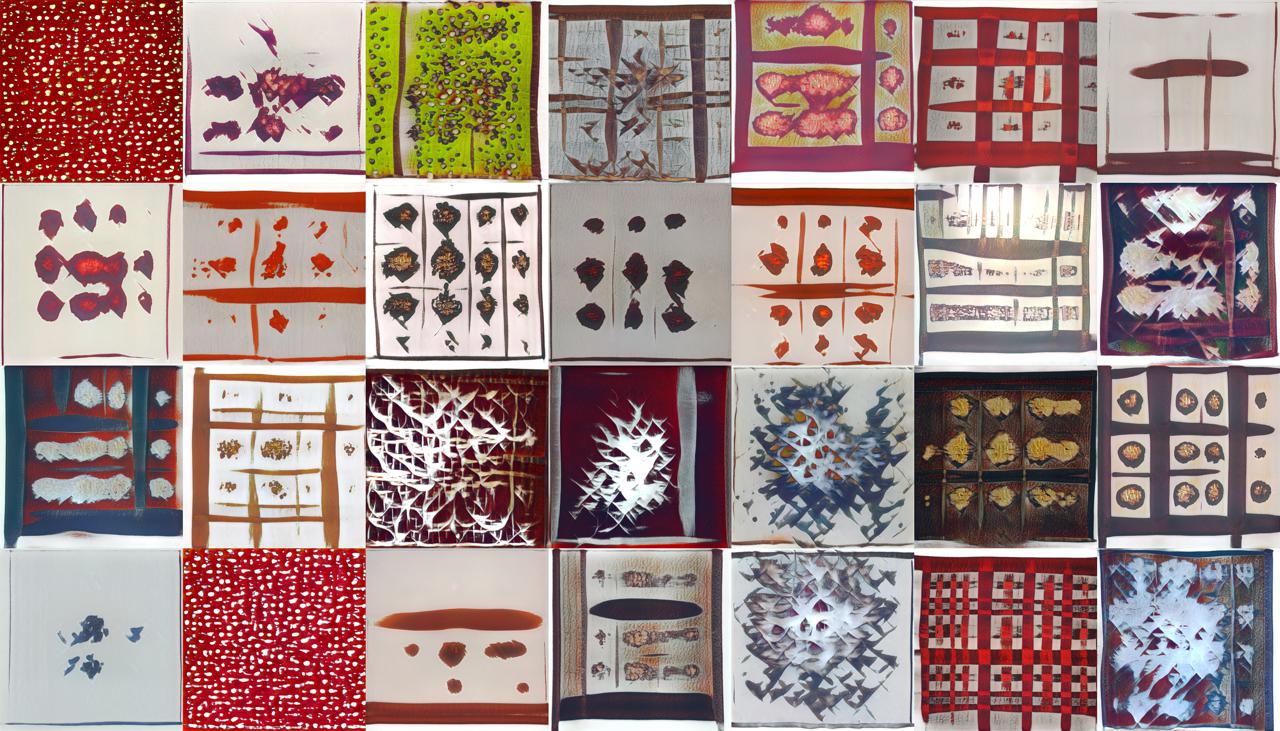
StyleGAN Trained Model on All Quilts
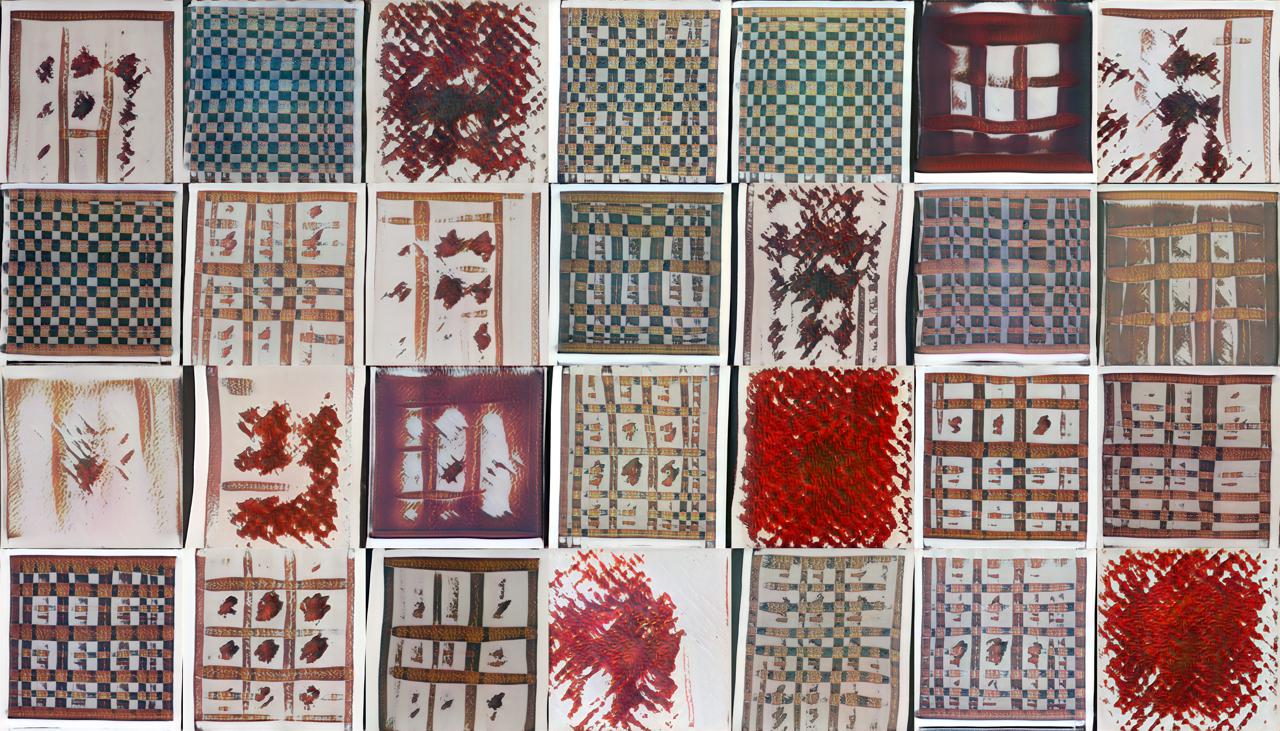
StyleGAN Trained Model on Quilts of Hopi and Sioux Tribes
Initial Designs
Exploring and refining the project’s approach
Color Exploration Pages
Drafts of color explorations by landscapes and locations helped understand visual relationships and informed the final design. These drafts were abandoned due to complexity and the need for streamlined visualizations.
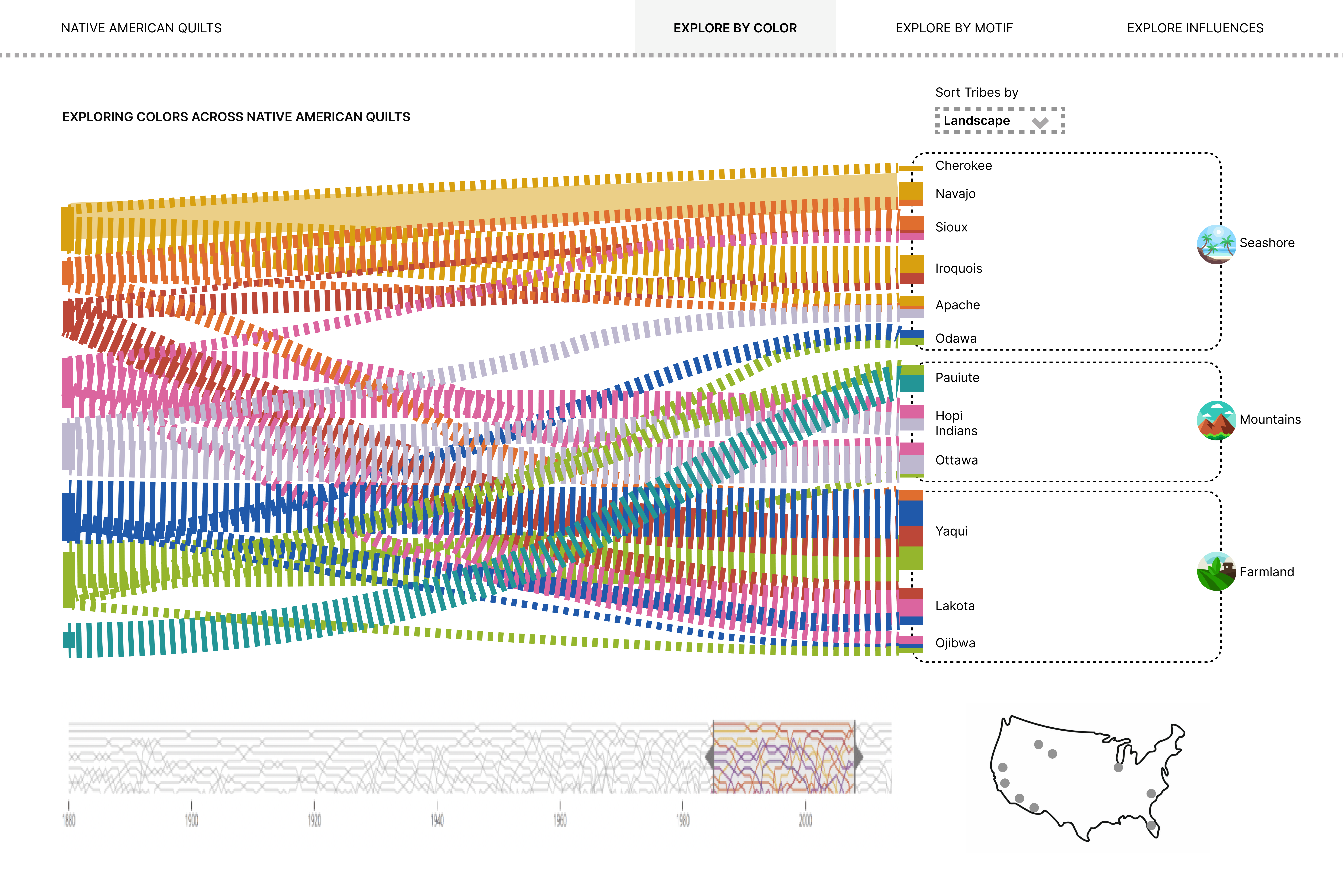
Concept Drafts of Color Explorations By Landscape
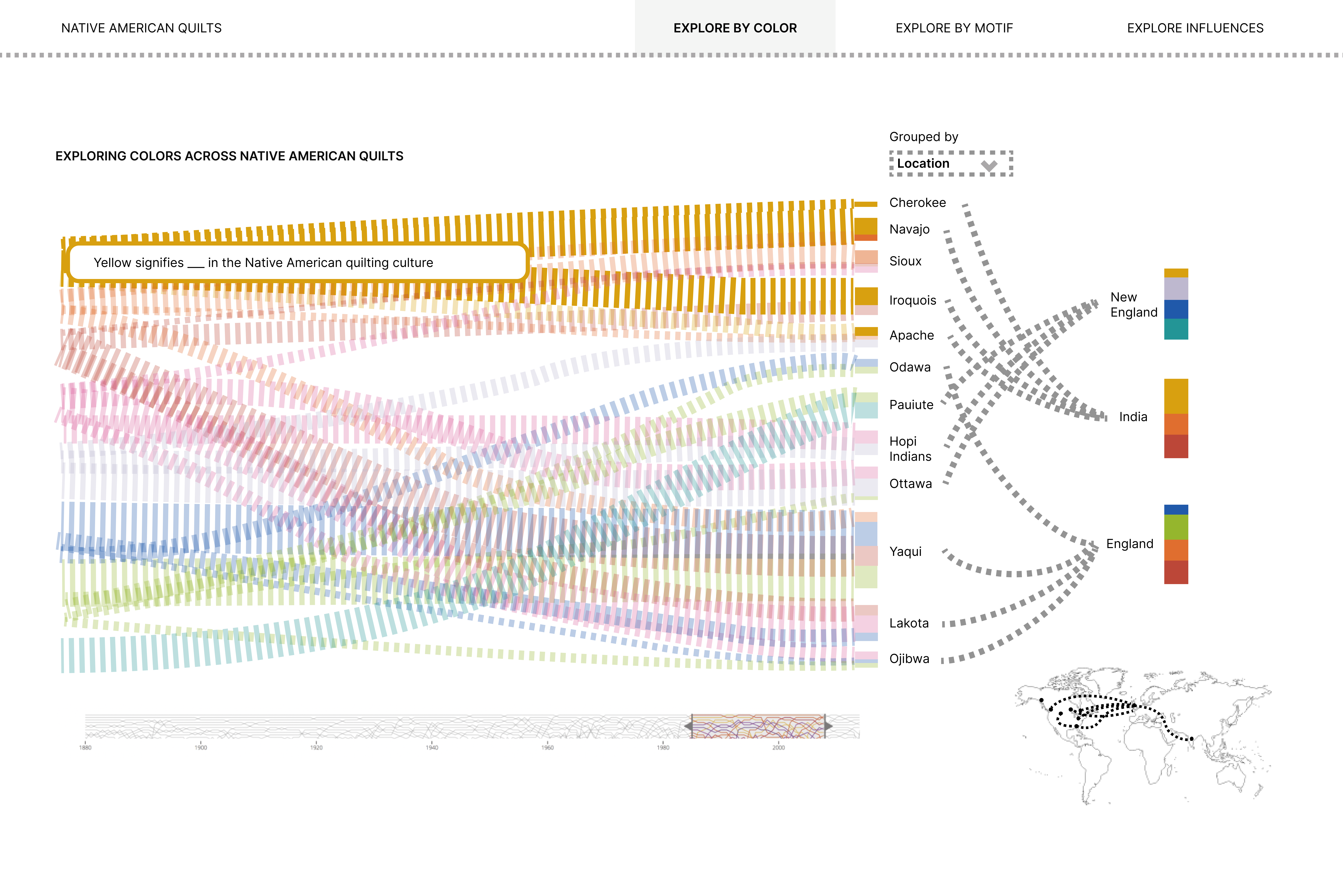
Concept Drafts of Color Explorations By Location
Generative Models
Using StyleGAN and RunwayML, models were trained on quilts from different tribes, exploring similarities and knowledge exchange between tribes like the Hopi and Sioux. These initial designs provided valuable insights but were refined for clearer and more meaningful visualizations.
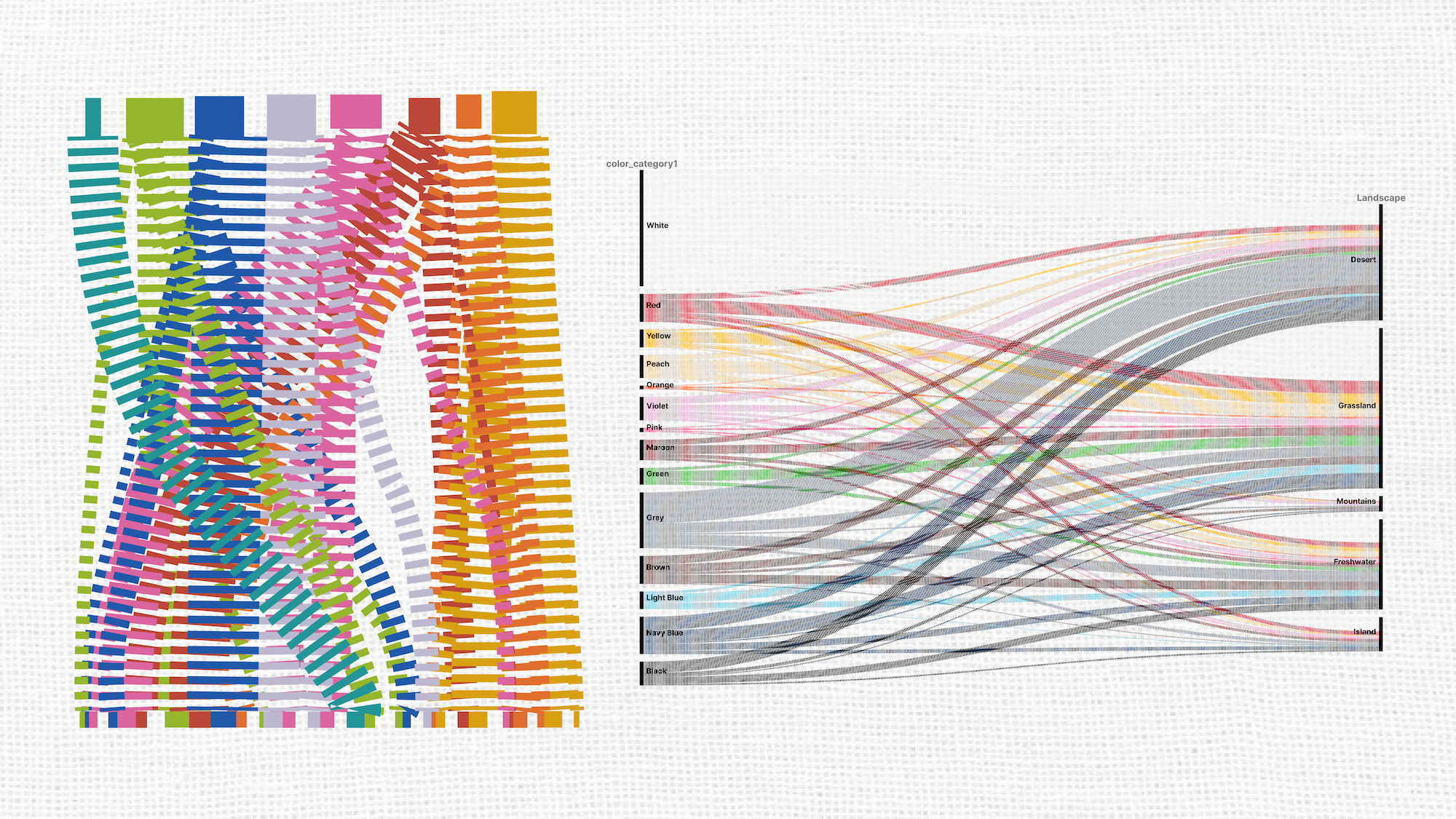
Alluvial Diagram of Color Categories and Explorations
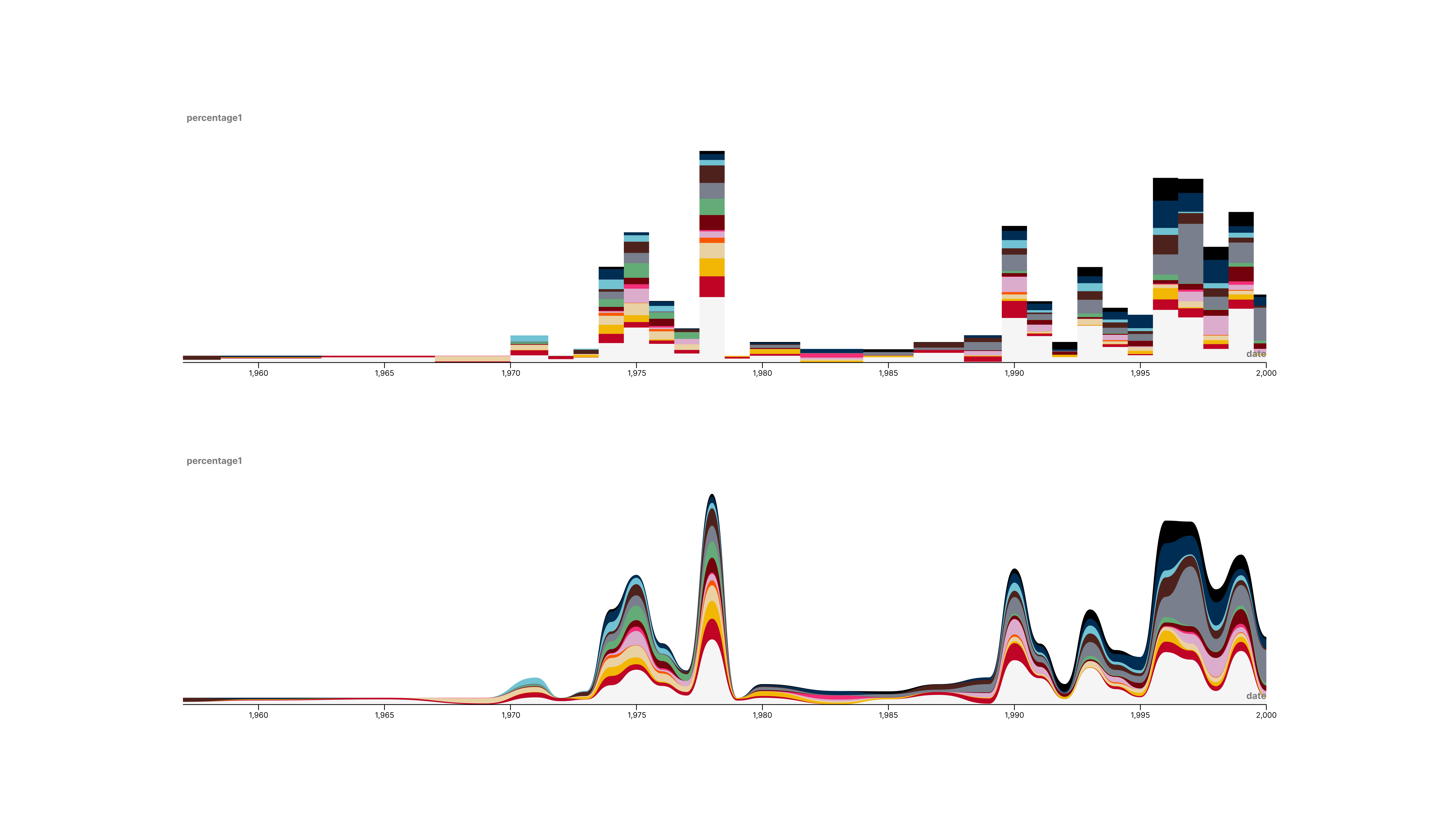
Color Extractions According to the Timeline
Visualization Exploration
Creating visual and interactive representations of quilting data
Using RAWGraphs and Figma, we designed visualizations exploring color usage and symbolism across quilts. These visualizations were refined through prototyping and expert feedback to ensure clarity and cultural sensitivity.
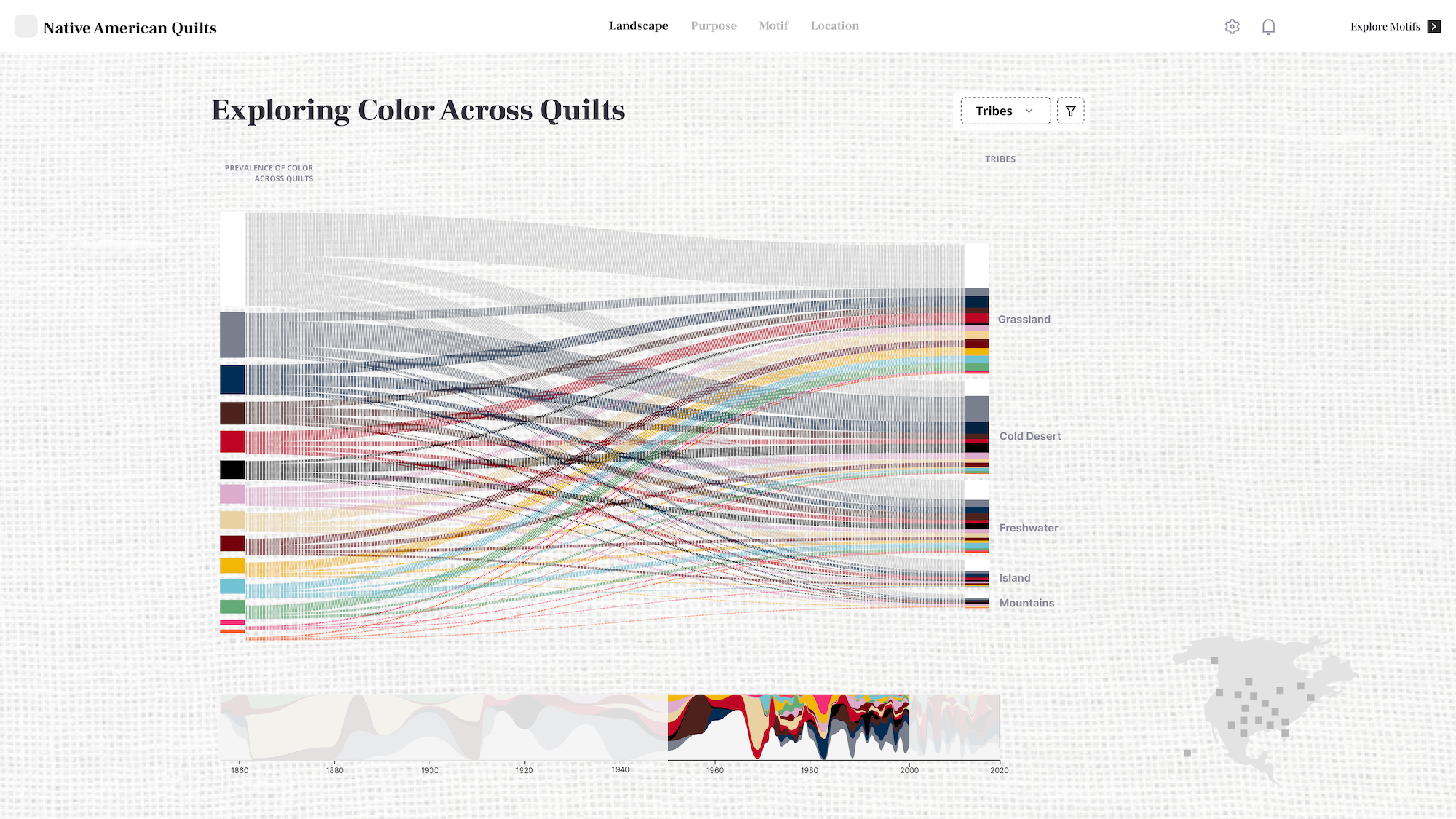
Implementation of Real Data
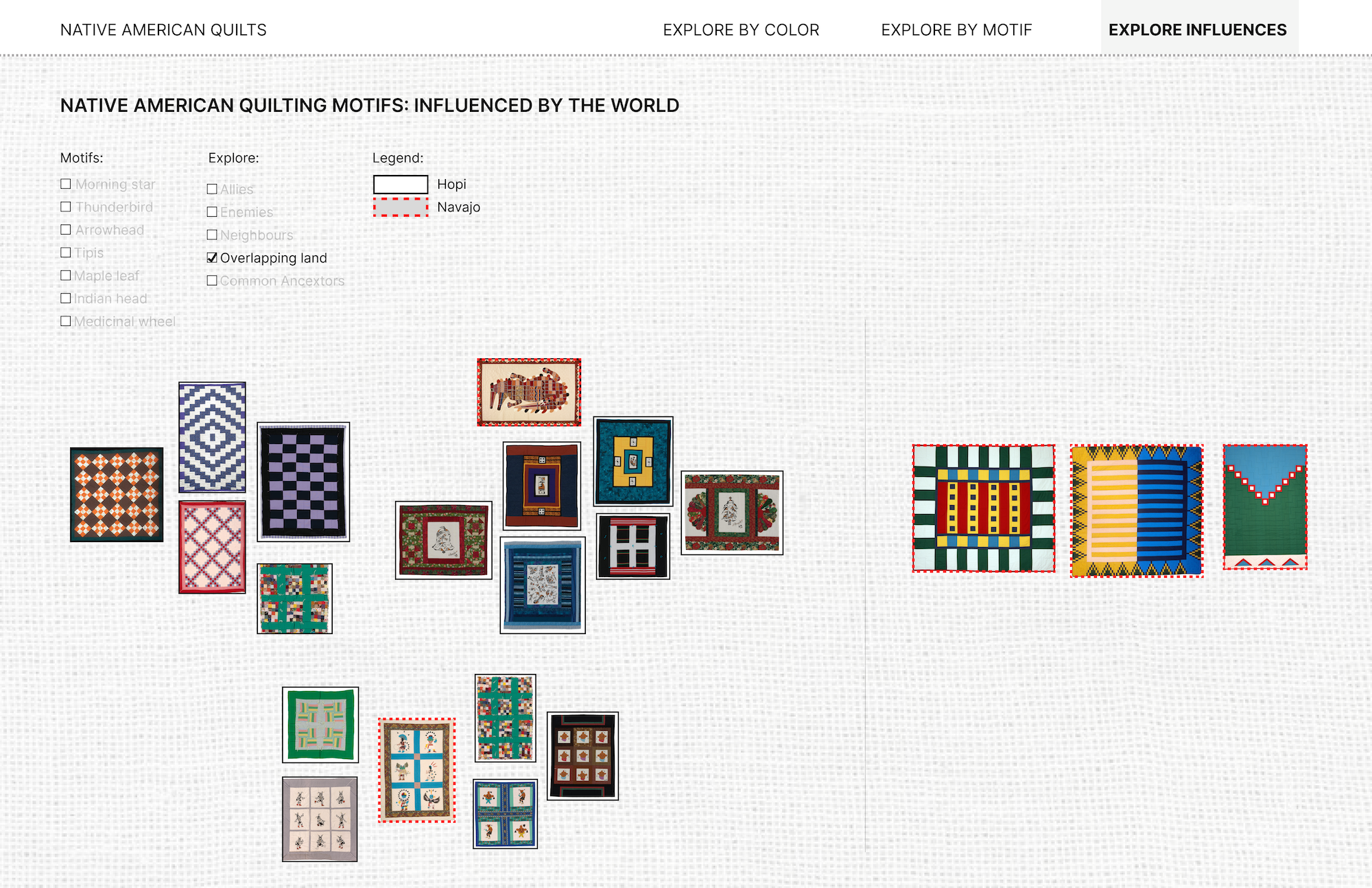
Influence Explorations By Tribes
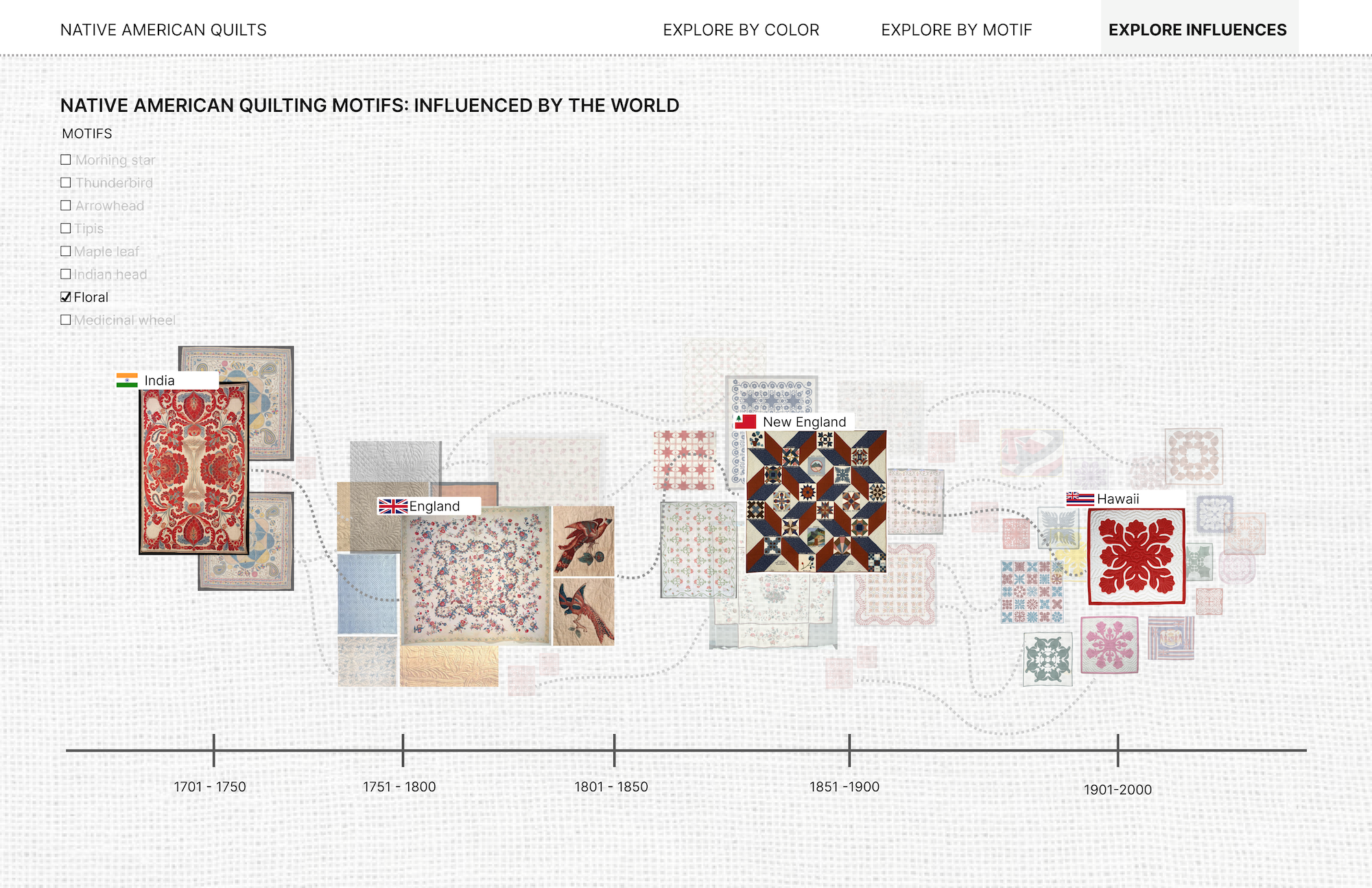
Influence Explorations By Motifs
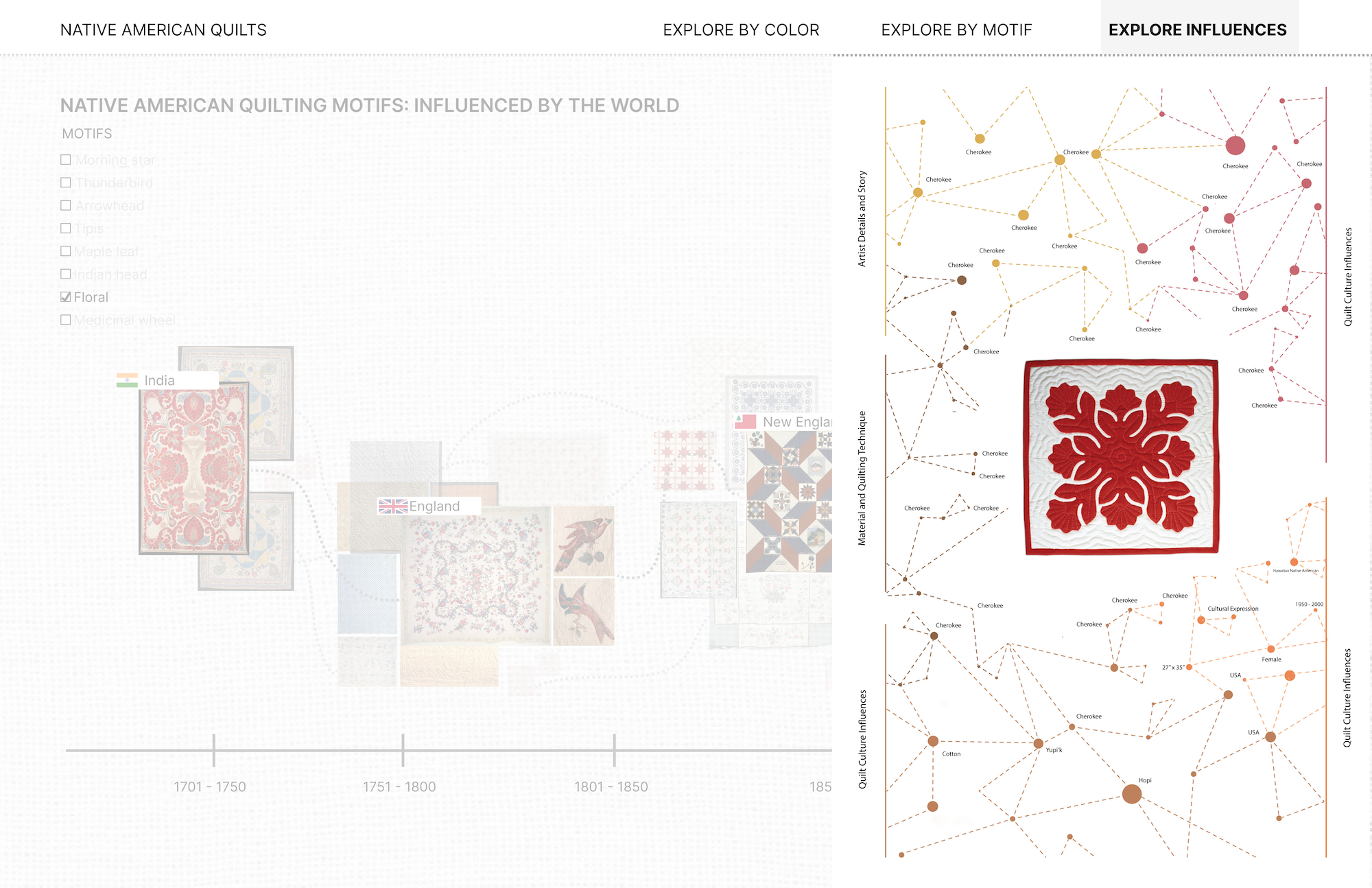
Influence Explorations By Motifs - Detail
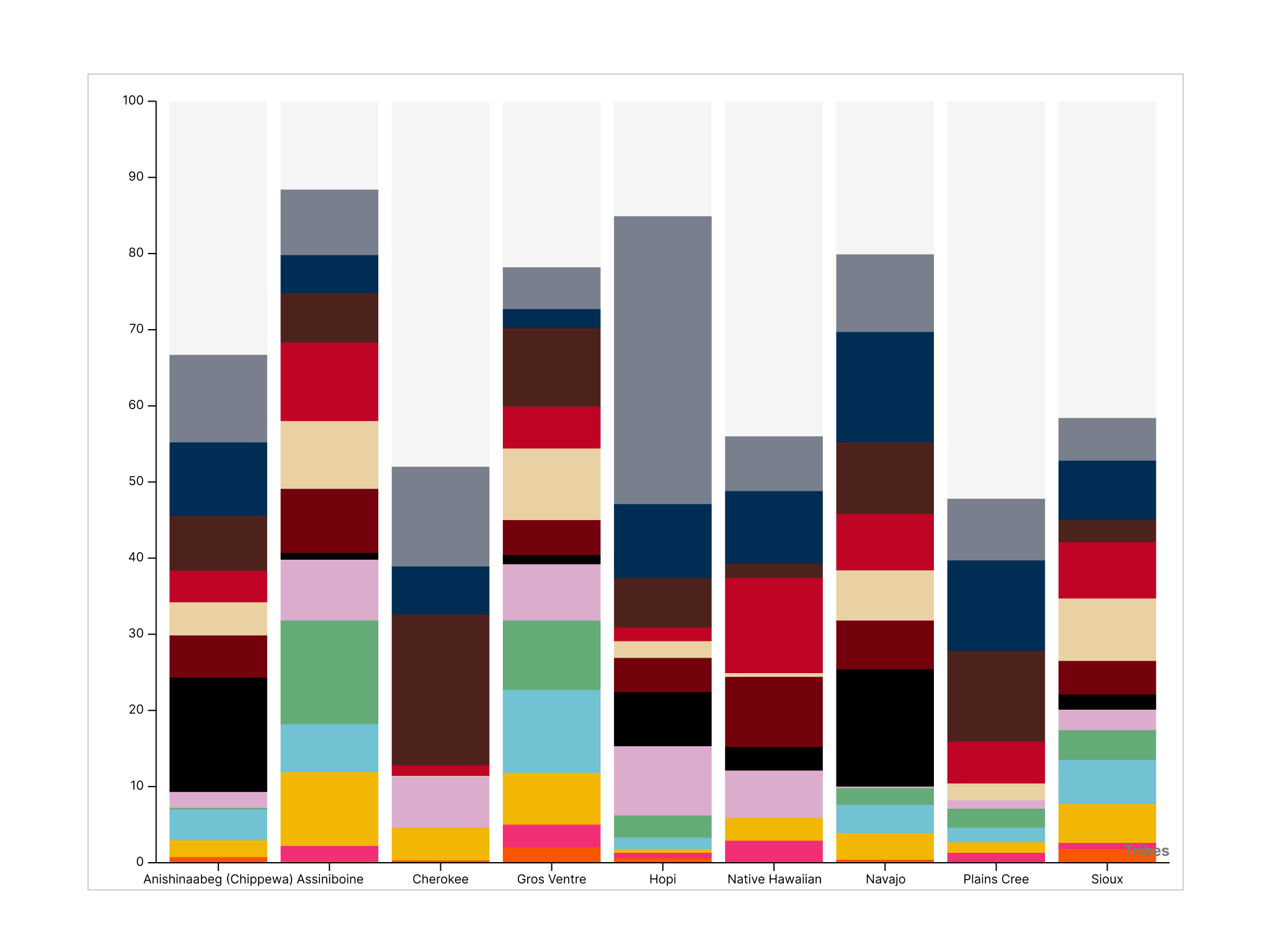
Color Usage Across Tribes
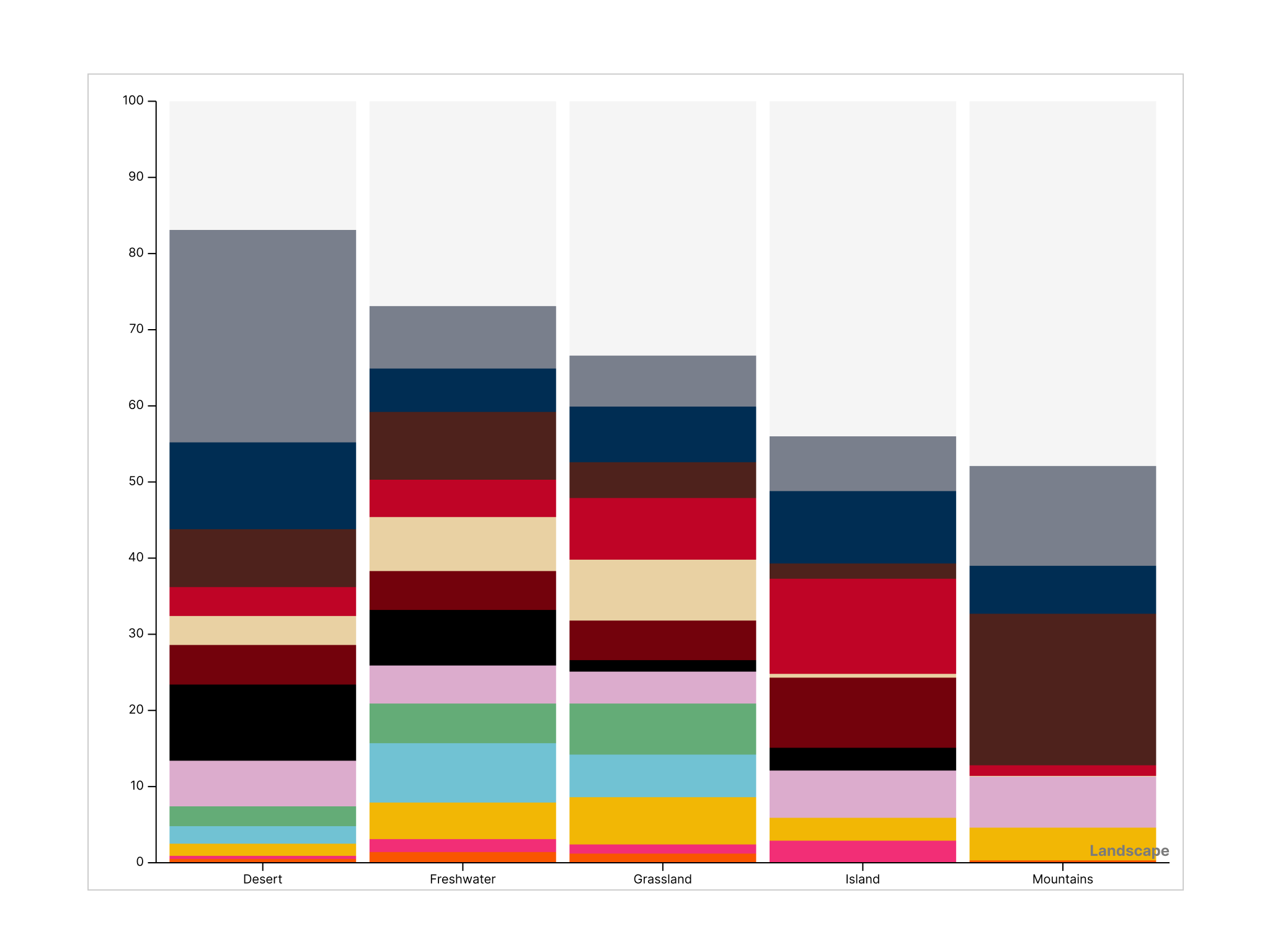
Color Usage Across Landscapes
Final Prototype
Interactive tool for exploring Native American quilting aesthetics
The final prototype includes visualizations that allow users to explore color usage, motifs, and cultural influences in Native American quilts. This tool promotes discovery and appreciation of this rich art form, ensuring cultural sensitivity and accuracy.
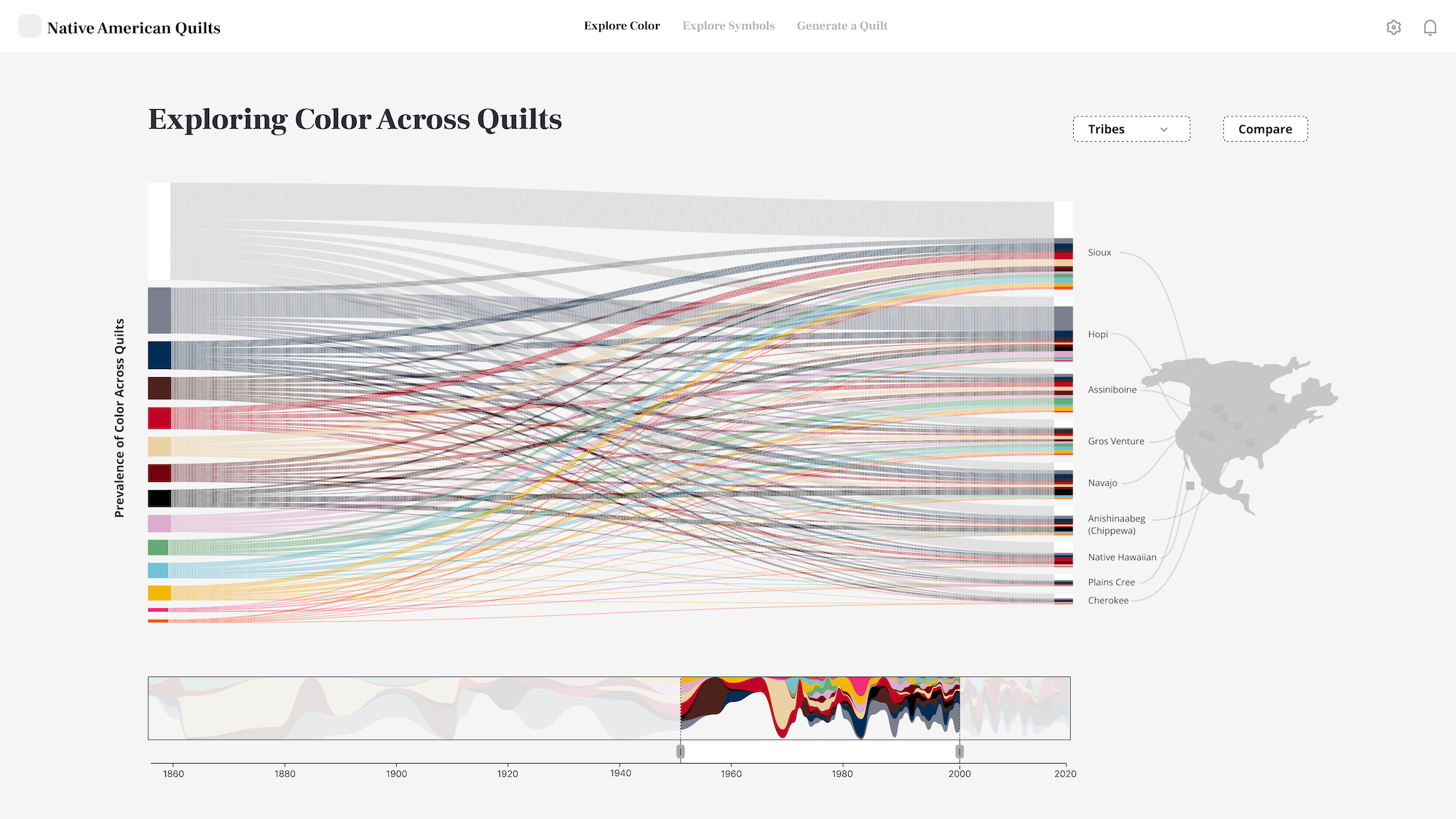
Exploring Color Across Quilts
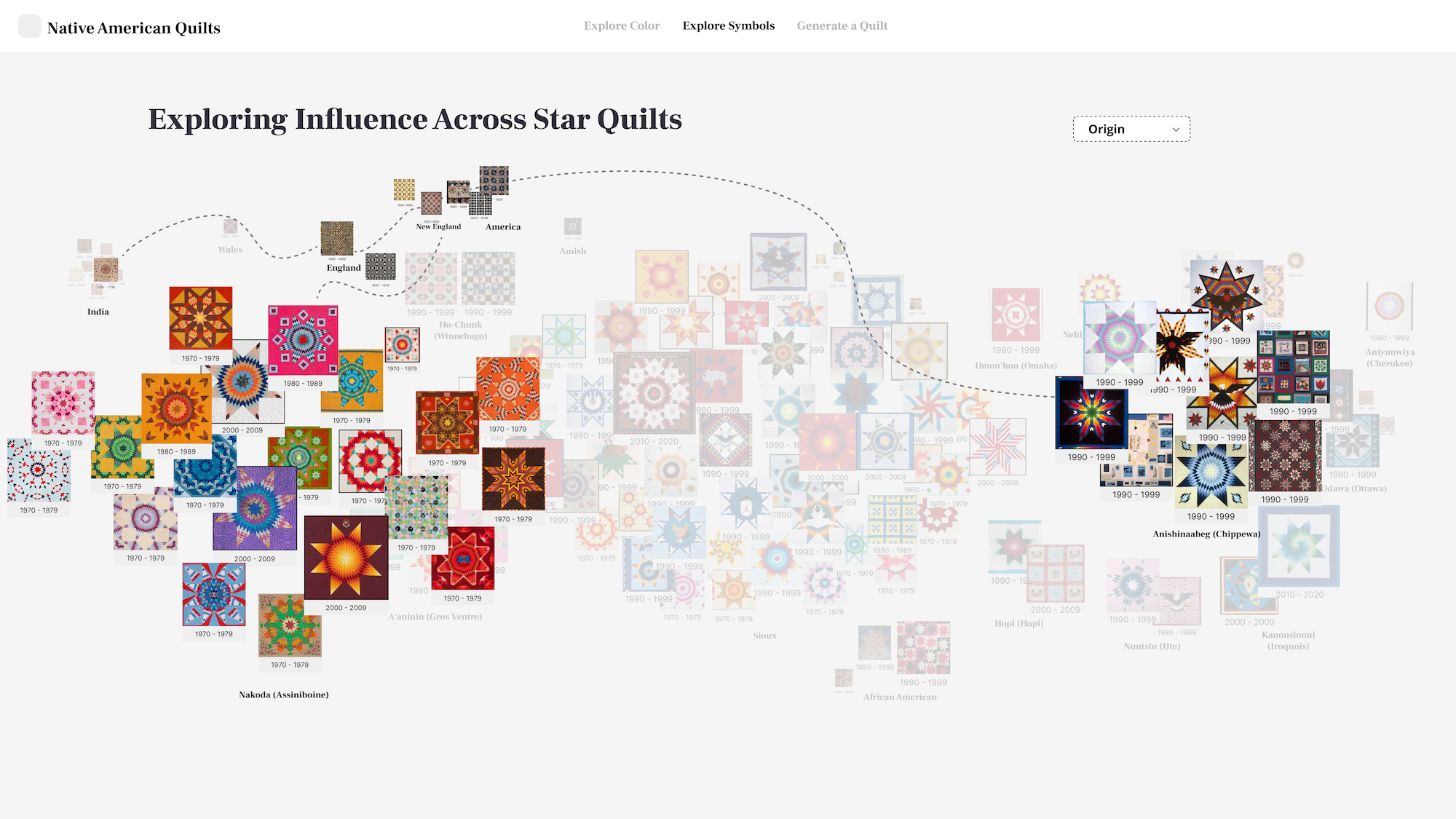
Exploring Influence Across Star Quilts
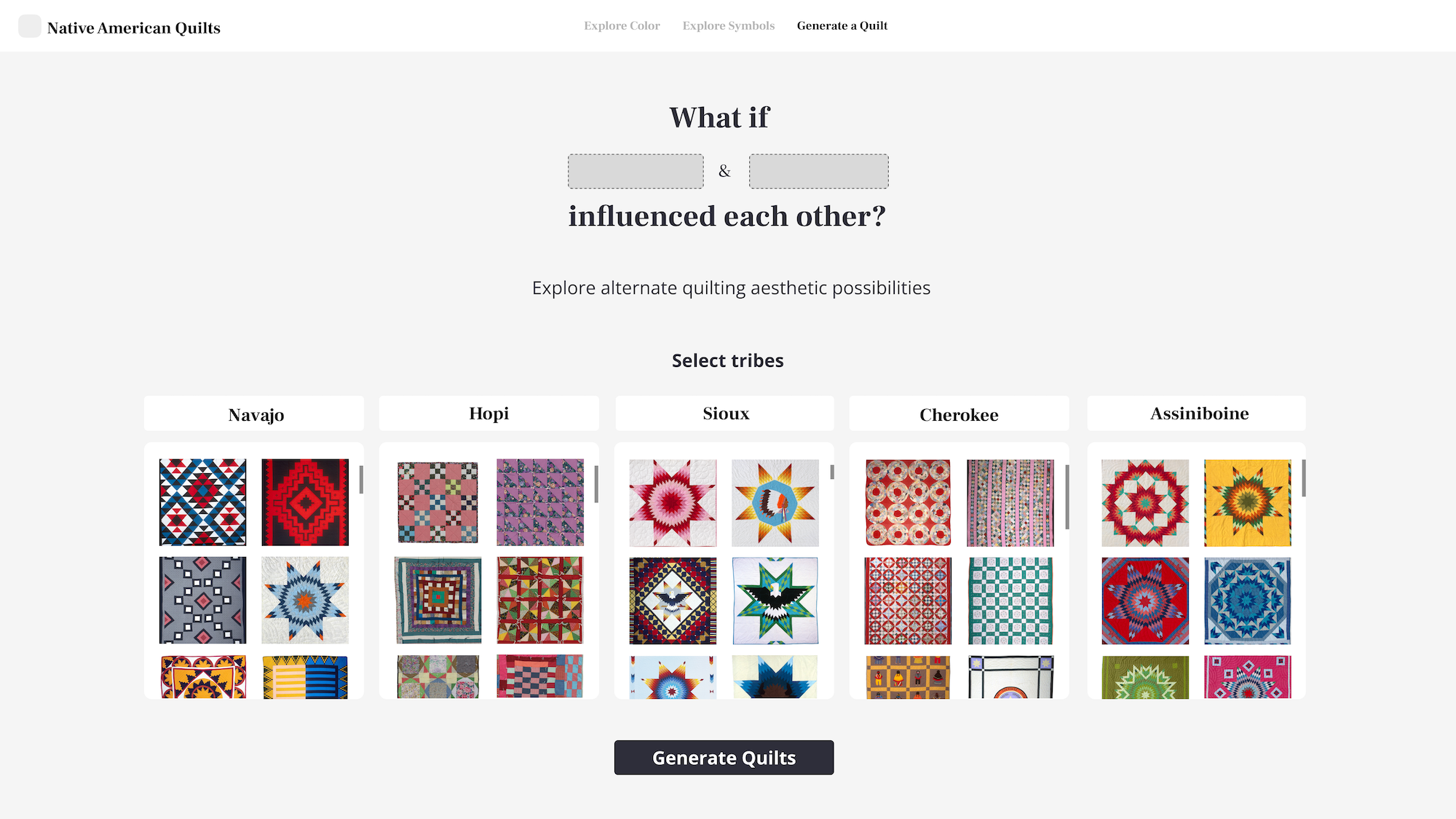
Generative Quilt Landing Page
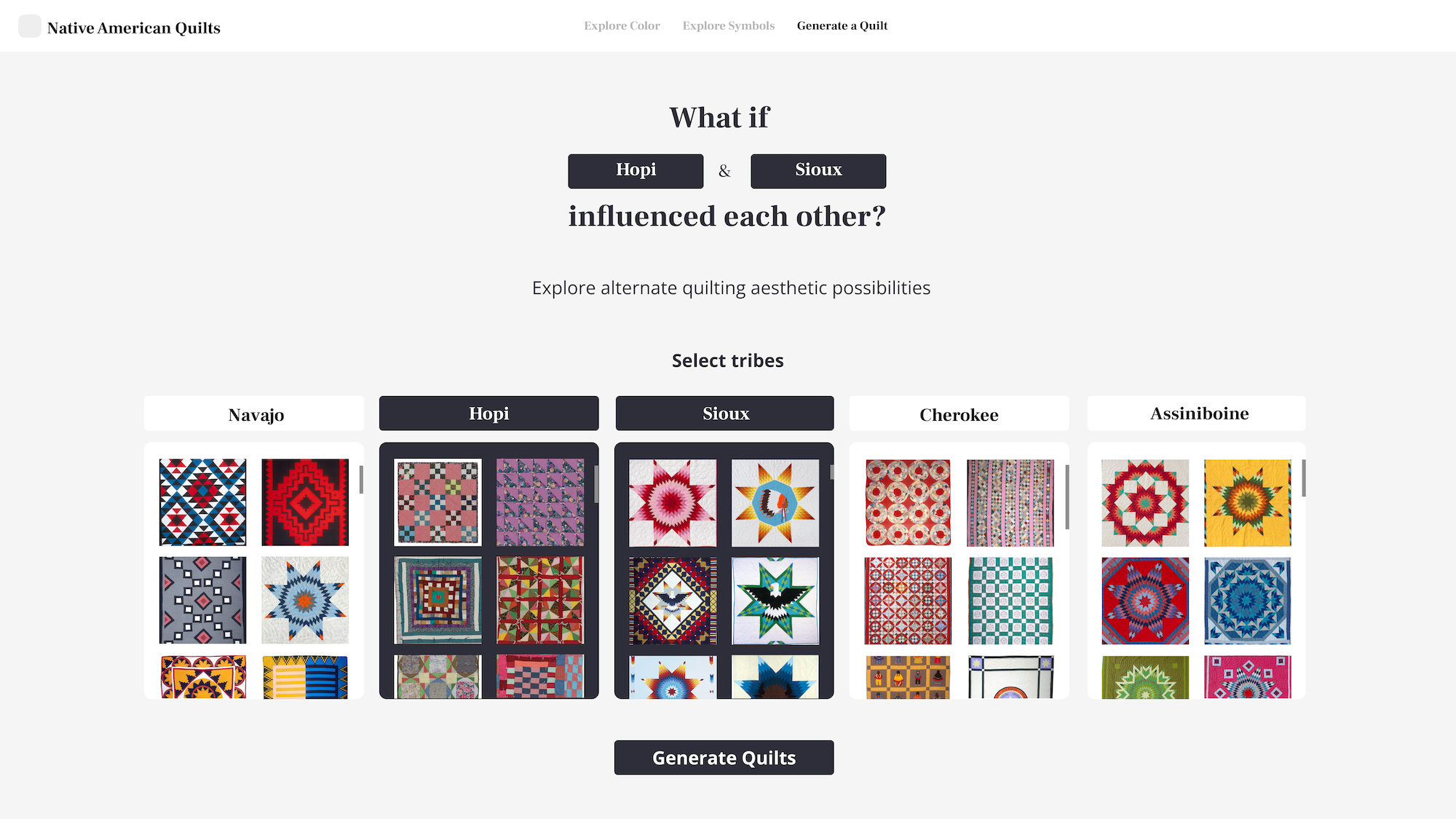
Generative Quilt Results Page
Impact
Promoting cultural awareness and appreciation
The project enhances understanding and appreciation of Native American quilting culture. By providing an interactive and educational tool, it fosters cultural awareness, highlights historical and contemporary influences, and encourages respectful engagement with indigenous art traditions.
Limitations
Acknowledging areas for improvement
The project faced challenges such as the lack of well-documented quilt images and diverse patterns. Future improvements include expanding the dataset, refining visualizations, and ensuring broader representation of different tribes.
Reflection
Learning from the exploration of Native American quilting aesthetics
This project emphasized the importance of cultural sensitivity and accurate representation. Engaging with experts and incorporating feedback were crucial in developing a meaningful tool. The experience underscored the value of iterative design and the potential of technology to reveal new perspectives on cultural heritage.